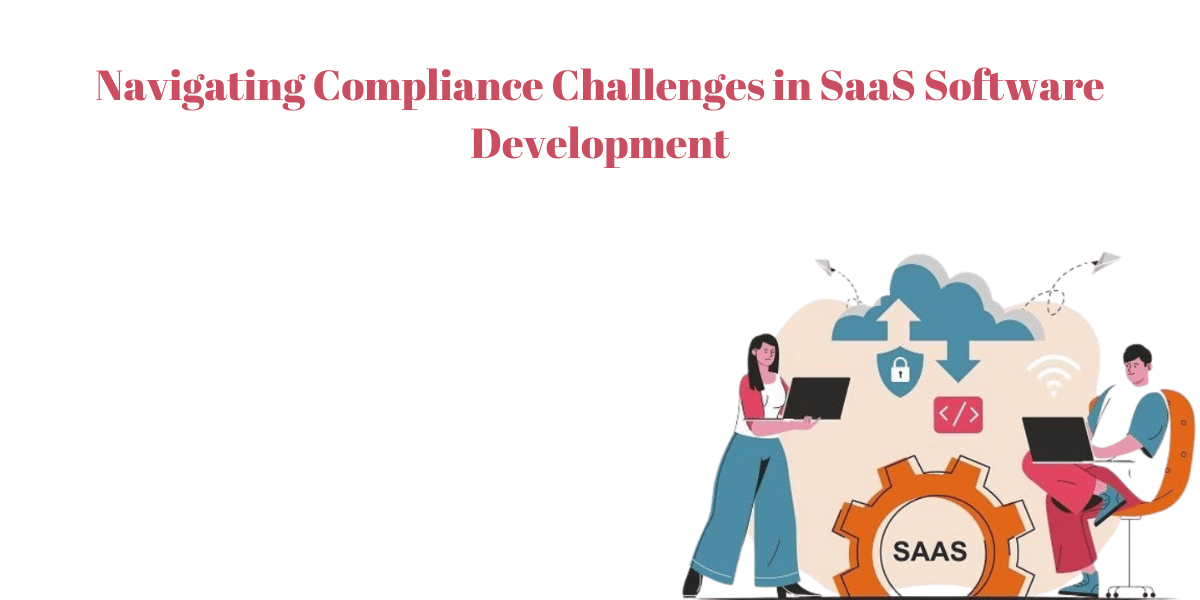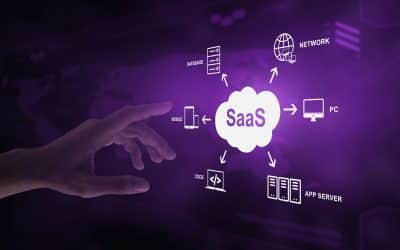In the dynamic realm of SaaS software development, where innovation converges with technology, navigating compliance challenges has become paramount. As the digital landscape evolves, so do the regulatory frameworks governing data protection, security, and privacy. This intricate interplay between technological advancement and regulatory compliance forms the backdrop for developers and businesses engaged in SaaS solutions.
The introduction of compliance measures is essential not only to meet legal requirements but also to build trust among users and stakeholders. From adhering to established standards like GDPR to addressing emerging concerns in the ever-evolving cybersecurity landscape, SaaS developers find themselves at the nexus of technological creativity and regulatory responsibility. This article delves into the multifaceted landscape of compliance challenges in SaaS software development, offering insights, best practices, and strategies to successfully navigate the intricate web of legal, security, and privacy obligations that characterize this dynamic industry.
Regulatory Landscape for SaaS Software
The regulatory landscape for Software as a Service (SaaS) is a complex terrain shaped by a multitude of global, regional, and industry-specific standards. As the digital ecosystem expands, governments and regulatory bodies have heightened their focus on data protection, privacy, and security. In Europe, the General Data Protection Regulation (GDPR) stands as a prominent force, dictating strict guidelines for the processing and storage of personal data.
Similarly, the United States has seen the emergence of sector-specific regulations, such as the Health Insurance Portability and Accountability Act (HIPAA) for healthcare data and the California Consumer Privacy Act (CCPA) for consumer data rights. Beyond these, various countries are implementing their own data protection laws, adding layers of complexity for SaaS developers operating on a global scale.
Industry standards like ISO/IEC 27001 further contribute to the regulatory matrix by providing a framework for information security management systems. Navigating this intricate regulatory landscape necessitates a comprehensive understanding of these standards, proactive compliance measures, and the ability to adapt to evolving legal frameworks. SaaS software developers must remain vigilant, continuously monitoring and adjusting their practices to ensure alignment with the ever-changing regulatory expectations, thereby fostering trust among users and mitigating the risks associated with non-compliance
Key Compliance Standards for SaaS Development
Key compliance standards form the bedrock of Software as a Service (SaaS) development, outlining the mandatory requirements that organizations must adhere to in order to ensure legal and ethical operations. One of the foremost standards is the General Data Protection Regulation (GDPR), a European Union directive that governs the processing and handling of personal data. SaaS developers operating in or serving EU markets must meticulously incorporate GDPR principles into their software architecture and data management practices.
Additionally, the Health Insurance Portability and Accountability Act (HIPAA) in the United States sets stringent guidelines for safeguarding healthcare data, imposing specific requirements on the storage and transmission of sensitive medical information. The Payment Card Industry Data Security Standard (PCI DSS) is another critical standard, focusing on securing credit card information during online transactions.
Furthermore, the International Organization for Standardization (ISO) offers the ISO/IEC 27001 standard, which provides a globally recognized framework for information security management systems, assisting SaaS developers in establishing robust security protocols. These key compliance standards collectively create a comprehensive framework that addresses data privacy, security, and industry-specific requirements. Successfully integrating these standards into SaaS development practices not only ensures legal compliance but also fosters user trust, as businesses demonstrate their commitment to protecting sensitive information in an increasingly interconnected and data-driven digital landscape.
Understanding Data Protection Regulations
Understanding data protection regulations is imperative for any entity engaged in Software as a Service (SaaS) development, as these regulations constitute the cornerstone of responsible and lawful data management practices. At the forefront of these regulations is the General Data Protection Regulation (GDPR), a comprehensive European Union legislation designed to protect individuals’ privacy rights and regulate the processing of personal data.
GDPR mandates strict consent mechanisms, transparent data handling practices, and the right to erasure, necessitating SaaS developers to embed these principles into their software architecture. Additionally, jurisdictions like the United States have their own data protection regulations, such as the California Consumer Privacy Act (CCPA), which grants consumers greater control over their personal information.
SaaS developers must be adept at navigating these diverse regulations, ensuring compliance with jurisdiction-specific requirements to avoid legal ramifications. Beyond geographical boundaries, industries often have their own set of data protection rules; for instance, the healthcare sector adheres to the Health Insurance Portability and Accountability Act (HIPAA), underscoring the need for heightened data security in medical contexts. In comprehending and implementing these regulations, SaaS developers not only mitigate legal risks but also cultivate user trust by demonstrating a commitment to safeguarding sensitive information, thereby reinforcing the integrity and ethical standards of their software solutions in an increasingly interconnected and regulated digital landscape.
GDPR Compliance in SaaS Software Development
GDPR compliance in Software as a Service (SaaS) software development stands as a critical imperative in the contemporary digital landscape. The General Data Protection Regulation (GDPR), enforced by the European Union, aims to safeguard individuals’ privacy rights by regulating the processing and transfer of personal data.
SaaS developers must meticulously integrate GDPR principles into their development processes, emphasizing transparency, user consent, and the secure handling of personal information. Ensuring GDPR compliance involves implementing robust data protection measures, such as anonymization and encryption, to mitigate the risk of unauthorized access or data breaches. SaaS providers must also facilitate user rights, including the right to access, rectify, and erase personal data upon user request. Consent mechanisms for data processing must be clear and explicit, with users having the option to opt in or out, and developers must maintain comprehensive documentation detailing data processing activities.
The GDPR’s extraterritorial scope further necessitates compliance efforts by SaaS software solutions worldwide if they process data related to EU residents. Non-compliance can result in severe penalties, emphasizing the importance of prioritizing GDPR adherence in SaaS development. By embracing GDPR compliance, SaaS developers not only adhere to legal obligations but also cultivate trust among users, demonstrating a commitment to respecting privacy and data protection in an era where digital trust is paramount.
Addressing Security and Privacy Concerns
Addressing security and privacy concerns is paramount in Software as a Service (SaaS) development to ensure the integrity, confidentiality, and availability of user data. SaaS providers must employ a multi-faceted approach to mitigate security risks and safeguard user privacy throughout the software lifecycle. This includes implementing robust authentication mechanisms, such as multi-factor authentication, to prevent unauthorized access to sensitive data. Encryption techniques, both in transit and at rest, are essential for protecting data from interception or unauthorized disclosure. Regular security assessments, including penetration testing and vulnerability scanning, help identify and address potential vulnerabilities in the software infrastructure. Additionally, establishing stringent access controls and role-based permissions limits the exposure of sensitive data to only authorized users.
Privacy concerns are equally significant, with regulations like the General Data Protection Regulation (GDPR) and the California Consumer Privacy Act (CCPA) imposing strict requirements on the collection, storage, and processing of personal information. SaaS providers must adopt privacy by design principles, embedding privacy controls into the SaaS software architecture from the outset. Transparent data handling practices, including clear privacy policies and user consent mechanisms, empower users to make informed decisions about their data. Regular audits and compliance assessments ensure adherence to applicable privacy regulations and industry standards.
Furthermore, maintaining data residency and localization practices can address concerns related to data sovereignty and jurisdiction-specific regulations. Proactive incident response plans and data breach notification procedures enable swift action in the event of a security incident, minimizing the impact on users and mitigating legal and reputational risks. By prioritizing security and privacy considerations throughout the development process, SaaS providers can build trust with users and demonstrate their commitment to protecting sensitive information in an increasingly interconnected digital landscape.
Navigating Legal and Contractual Obligations
Navigating legal and contractual obligations is a crucial facet of Software as a Service (SaaS) development, as developers engage in a complex web of relationships with users, clients, and third-party service providers. From drafting and enforcing user agreements to managing vendor contracts, SaaS providers must navigate a multifaceted legal landscape. Clear and comprehensive terms of service agreements are essential for defining the rights and responsibilities of both the SaaS provider and users, addressing issues like data ownership, intellectual property rights, and service-level commitments. Ensuring that these agreements are legally sound and enforceable is vital to establishing a foundation of trust and minimizing disputes.
Moreover, SaaS developers often rely on third-party services and components, necessitating diligent contract management to safeguard against potential legal and security risks. Vendor contracts must be carefully scrutinized to ensure alignment with regulatory requirements, data protection standards, and industry best practices. Addressing issues such as data processing responsibilities, confidentiality, and indemnification clauses becomes imperative to mitigate legal liabilities.
Beyond user agreements and vendor contracts, compliance with industry-specific regulations and global data protection laws adds another layer of complexity. SaaS app development company must stay abreast of evolving legal frameworks, adapting their practices to meet new requirements and mitigate risks associated with non-compliance. The nuanced interplay of legal and contractual obligations underscores the need for SaaS developers to engage legal expertise, fostering a proactive and informed approach to legal compliance that safeguards both the interests of the business and the rights of users and stakeholders.
Compliance Checks in the Software Development Lifecycle
Integrating compliance checks into the Software Development Lifecycle (SDLC) is paramount for ensuring that Software as a Service (SaaS) products adhere to regulatory standards and industry best practices. This proactive approach involves embedding compliance considerations at every stage of the SDLC, from initial design to deployment and ongoing maintenance. In the requirements gathering phase, developers must identify and document relevant compliance requirements, considering data protection, security, and any industry-specific regulations. This forms the basis for creating a compliant software architecture that aligns with legal and regulatory frameworks.
During the design and planning stages, compliance considerations inform decisions related to data handling, encryption protocols, and access controls. Security and privacy-by-design principles are essential to mitigate risks from the outset, minimizing the likelihood of non-compliance issues later in the development process. As development progresses, continuous testing and validation against compliance requirements become integral components. Automated tools and manual assessments help identify and rectify potential vulnerabilities, ensuring that the software meets established standards.
The deployment phase involves thorough validation to confirm that the final product complies with all relevant regulations. Regular audits and assessments post-deployment help maintain compliance in the evolving landscape of data protection and cybersecurity. Ongoing monitoring and updates throughout the maintenance phase are crucial to address emerging threats, evolving regulations, and to adapt the software to changing compliance standards. By weaving compliance checks into each step of the SDLC, SaaS developers not only reduce the risk of non-compliance but also establish a foundation for building secure, trustworthy, and legally compliant software solutions.
Importance of Transparent Data Handling
Transparent data handling is a fundamental pillar in Software as a Service (SaaS) development, playing a pivotal role in establishing trust, complying with regulations, and ensuring ethical data practices. Users entrust SaaS providers with sensitive information, and the way data is collected, processed, and stored significantly influences the user experience and the reputation of the service. Transparent data handling involves clearly communicating to users how their data will be utilized, providing detailed privacy policies, and obtaining explicit consent for data processing activities. This transparency not only empowers users to make informed decisions about sharing their information but also demonstrates the commitment of SaaS providers to ethical and responsible data practices.
From a regulatory perspective, transparency is a core tenet of data protection laws such as the General Data Protection Regulation (GDPR) and the California Consumer Privacy Act (CCPA). Compliance with these regulations necessitates clear and concise communication about data handling practices, and any deviations from the stated policies require user consent. Transparent data handling also mitigates the risk of legal challenges and regulatory fines by ensuring that users are aware of how their data will be used and are given the opportunity to exercise their rights regarding data access, correction, and deletion.
Moreover, transparent data handling contributes to building a positive relationship between SaaS providers and their user base, fostering trust and loyalty. When users understand how their data is managed and have confidence in the security measures implemented, they are more likely to engage with the service and recommend it to others. As data privacy concerns continue to gain prominence, the importance of transparent data handling cannot be overstated, as it forms the foundation for responsible and user-centric SaaS development in an interconnected digital landscape.
Best Practices for Secure User Authentication
Implementing robust and secure user authentication is paramount in Software as a Service (SaaS) development to safeguard user accounts and sensitive information. Best practices for secure user authentication begin with the use of strong password policies, encouraging users to create complex passwords and enforcing periodic updates. Additionally, adopting multi-factor authentication (MFA) enhances security by requiring users to provide multiple forms of identification, such as a password and a verification code sent to their mobile device. OAuth and OpenID Connect protocols should be considered for secure authentication with external identity providers, reducing the reliance on local authentication mechanisms.
Furthermore, the storage of user credentials demands meticulous attention. Employing salted and hashed password storage techniques adds an extra layer of protection against unauthorized access in case of a data breach. Regular security audits and vulnerability assessments should be conducted to identify and address potential weaknesses in the authentication system. Session management is equally crucial, necessitating the use of secure session tokens and timeouts to minimize the risk of session hijacking. Developers should stay informed about emerging authentication technologies, such as biometrics or adaptive authentication, to enhance security measures.
Educating users about secure authentication practices, including the risks of password reuse and the importance of promptly reporting suspicious activities, contributes to a comprehensive security strategy. Continuous monitoring and logging of authentication events enable prompt detection of anomalous activities, triggering timely responses to potential security threats. By incorporating these best practices into the authentication process, SaaS developers reinforce the resilience of their systems, ensuring that user accounts remain secure and protected in an ever-evolving landscape of cybersecurity challenges.
Ensuring Encryption and Data Integrity
Ensuring encryption and data integrity is a cornerstone of secure Software as a Service (SaaS) development, forming a robust defense against unauthorized access and data tampering. Adopting encryption protocols for both data in transit and at rest is fundamental in protecting sensitive information from interception and unauthorized disclosure. Transport Layer Security (TLS) or its predecessor, Secure Sockets Layer (SSL), should be implemented to secure data during communication between users and the SaaS application, safeguarding it from potential eavesdropping or man-in-the-middle attacks.
Equally important is the encryption of stored data. SaaS providers must utilize strong encryption algorithms to protect data stored in databases or cloud storage, ensuring that even if unauthorized access occurs, the data remains unintelligible without the corresponding decryption keys. Key management practices play a vital role in maintaining the integrity of the encryption process, necessitating secure storage and rotation of cryptographic keys.
Data integrity, on the other hand, involves guaranteeing the accuracy and consistency of data throughout its lifecycle. Hash functions and checksums are employed to verify the integrity of data during transmission or storage, allowing for the detection of any unauthorized alterations. Regular integrity checks and validation processes should be integrated into the software development lifecycle to identify and rectify any inconsistencies promptly.
By prioritizing encryption and data integrity measures, SaaS software development companies not only safeguard user data against breaches and unauthorized access but also demonstrate a commitment to maintaining the trust of users and adhering to privacy and security best practices. In an era where data is a valuable asset, these measures are critical components of a comprehensive security strategy that underpins the reliability and resilience of SaaS applications.
Compliance Monitoring and Auditing in SaaS
Compliance monitoring and auditing in Software as a Service (SaaS) development are indispensable processes that ensure ongoing adherence to regulatory standards, security protocols, and industry best practices. Continuous compliance monitoring involves the real-time surveillance of SaaS systems to identify any deviations from established compliance frameworks. Automated tools and alerts play a pivotal role in detecting potential violations, enabling swift corrective actions. Regular internal audits assess the effectiveness of implemented controls, examining data handling practices, security measures, and overall compliance with legal and regulatory requirements. These proactive measures not only mitigate the risk of non-compliance but also contribute to the early detection and resolution of security vulnerabilities.
External audits further strengthen the compliance posture of SaaS providers by subjecting their systems and processes to independent scrutiny. Third-party auditors assess adherence to specific standards, such as ISO/IEC 27001 or SOC 2, providing an objective evaluation of security controls and data protection practices. The findings from compliance audits often lead to valuable insights for enhancing security measures and refining internal processes.
Documentation is a crucial aspect of compliance monitoring and auditing. SaaS developers must maintain comprehensive records of policies, procedures, and audit trails to demonstrate a commitment to compliance and provide evidence of due diligence. This documentation not only facilitates the auditing process but also serves as a valuable resource for addressing regulatory inquiries and legal challenges.
By integrating compliance monitoring and auditing into the fabric of SaaS development, providers establish a proactive and responsive approach to regulatory challenges. These processes not only safeguard user data but also fortify the reputation of SaaS platforms by instilling confidence in users and stakeholders, emphasizing a commitment to maintaining the highest standards of security and compliance in the rapidly evolving digital landscape.
Managing Access Controls and Permissions
Effectively managing access controls and permissions is a cornerstone of secure Software as a Service (SaaS) development, ensuring that users have appropriate levels of access to data and functionalities based on their roles and responsibilities. Access control mechanisms are designed to restrict unauthorized users from accessing sensitive information, preventing potential security breaches. Role-based access control (RBAC) is commonly employed, where users are assigned specific roles, and each role is associated with predefined permissions. This granular approach allows SaaS developers to tailor access rights, limiting users to only the data and features essential for their tasks.
Implementing the principle of least privilege is critical in managing access controls, meaning that users are granted the minimum level of access necessary to perform their duties. Regular reviews and audits of access permissions help identify and rectify any discrepancies or unnecessary privileges, reducing the risk of unauthorized activities. Multi-factor authentication (MFA) adds an additional layer of security by requiring users to provide multiple forms of identification, enhancing access controls beyond mere usernames and passwords.
Access controls extend beyond user interactions to encompass programmatic access through APIs. SaaS providers must carefully manage API permissions to prevent unauthorized data access or modification. Additionally, privileged access management (PAM) systems assist in securing and monitoring the activities of users with elevated permissions.
A comprehensive access control strategy is vital for protecting sensitive data, ensuring compliance with privacy regulations, and preventing insider threats. SaaS developers must continually assess and adapt access controls as the system evolves, maintaining a proactive stance in the ever-changing landscape of cybersecurity challenges. By prioritizing access control mechanisms, SaaS providers bolster the security and integrity of their platforms, fostering user trust and confidence in their commitment to safeguarding data assets.
Challenges of Cross-Border Data Transfer Compliance
The challenges of cross-border data transfer compliance pose complex hurdles for Software as a Service (SaaS) developers, particularly in an era where digital information flows seamlessly across geographical boundaries. Divergent data protection regulations and privacy laws create a web of legal intricacies that demand meticulous attention to ensure compliance. The General Data Protection Regulation (GDPR) in the European Union, for instance, imposes stringent requirements on the transfer of personal data outside the EU, necessitating the use of mechanisms like Standard Contractual Clauses (SCCs) or Binding Corporate Rules (BCRs) to establish a lawful basis for cross-border data transfers. Other jurisdictions, such as the United States, have different frameworks, like the Privacy Shield, that require adherence to specific principles for data transfers.
The emergence of data localization laws in various countries further complicates matters, mandating that certain data be stored or processed within the borders of a specific region. Navigating these conflicting requirements poses significant challenges for SaaS developers operating on a global scale, requiring them to strike a delicate balance between facilitating data transfers for seamless service provision and complying with diverse and often conflicting regulatory frameworks. Ensuring robust security measures, encryption protocols, and comprehensive documentation of data processing activities becomes imperative in this context, as it not only enhances data protection but also aids in demonstrating compliance to regulatory authorities.
The dynamic nature of cross-border data transfer compliance underscores the importance of staying abreast of evolving regulations, adapting practices accordingly, and fostering a proactive approach to address the complexities associated with international data flows. As the regulatory landscape continues to evolve, SaaS developers must remain vigilant and agile in their strategies, collaborating with legal experts to navigate the intricate challenges posed by cross-border data transfer compliance.
Vendor Management in SaaS for Compliance
Vendor management in Software as a Service (SaaS) for compliance is a critical facet of ensuring the integrity, security, and legal adherence of SaaS applications. SaaS developers often rely on third-party vendors for various services, ranging from cloud hosting and data storage to authentication and analytics. The multifaceted nature of these vendor relationships introduces complexities related to regulatory compliance, as SaaS providers are accountable for the actions and security measures of their vendors. Establishing a robust vendor management program involves conducting thorough due diligence during the vendor selection process, assessing the vendor’s security practices, data handling procedures, and compliance with relevant regulations. Contracts and service-level agreements (SLAs) must explicitly outline the vendor’s responsibilities in terms of data protection, security, and legal compliance, ensuring alignment with the SaaS provider’s own obligations.
Regular monitoring and auditing of vendor activities are essential components of effective vendor management. This includes evaluating the vendor’s security controls, data protection measures, and any changes to their practices that may impact compliance. SaaS providers must stay vigilant, promptly addressing any non-compliance issues identified during audits and assessments. Maintaining open lines of communication with vendors and conducting regular reviews of their security and compliance practices contribute to a collaborative and proactive approach.
The increasing emphasis on data protection regulations, such as the General Data Protection Regulation (GDPR) and others, requires SaaS developers to extend their compliance efforts to the entire vendor ecosystem. This not only safeguards user data but also fortifies the overall compliance posture of SaaS applications, fostering trust among users and stakeholders who expect a commitment to the highest standards of security and legal adherence in the SaaS landscape.
Integrating Compliance into Agile Development
Integrating compliance into Agile development methodologies poses a unique set of challenges and opportunities for Software as a Service (SaaS) providers aiming to balance innovation with regulatory adherence. The Agile approach, known for its iterative and flexible nature, emphasizes rapid development cycles and continuous delivery, making it imperative to embed compliance practices seamlessly into the development lifecycle. This integration necessitates a shift-left approach, where compliance considerations are addressed from the project’s inception rather than retroactively. Engaging compliance experts alongside development teams promotes a shared understanding of regulatory requirements, allowing for the creation of user stories that encompass both functional and compliance-related aspects.
The implementation of compliance-as-code practices becomes crucial in an Agile environment, where automated testing tools can validate whether code adheres to compliance standards throughout the development process. Regular compliance sprints, dedicated to addressing regulatory requirements, allow teams to proactively tackle potential issues and incorporate compliance checks at each stage. Continuous monitoring and evaluation of compliance metrics provide real-time insights, enabling swift adjustments to development practices in response to evolving regulatory landscapes.
Moreover, fostering a culture of collaboration and communication between compliance, development, and operations teams is essential. Emphasizing transparency and regular feedback loops ensures that compliance considerations remain an integral part of Agile workflows. By embracing these principles, SaaS providers can reconcile the need for rapid innovation with regulatory compliance, fostering a dynamic and resilient development process that not only meets user needs but also adheres to the highest standards of security, privacy, and legal requirements.
Impact of Emerging Technologies on Compliance
The impact of emerging technologies on compliance within the realm of Software as a Service (SaaS) development is profound, ushering in both challenges and transformative possibilities. Artificial Intelligence (AI) and machine learning (ML), for instance, offer innovative solutions for automating compliance processes, enhancing the efficiency of risk assessments, and detecting anomalies in vast datasets. However, the adoption of these technologies introduces complexities related to the interpretability and explainability of algorithmic decision-making, particularly in areas such as data protection and privacy regulations. Blockchain technology, with its decentralized and tamper-resistant ledger, has the potential to revolutionize compliance by providing transparent and auditable records, especially in industries where data integrity is paramount.
Conversely, the proliferation of Internet of Things (IoT) devices presents new compliance challenges, particularly in terms of data security and privacy. The interconnected nature of IoT ecosystems requires careful consideration of regulations governing data collection, storage, and processing. Additionally, quantum computing, while promising unparalleled computational power, introduces concerns regarding the potential decryption of current encryption standards, necessitating the development of quantum-resistant cryptographic protocols to uphold data security.
As these emerging technologies continue to shape the digital landscape, SaaS developers must navigate a dynamic regulatory environment. Proactive collaboration between technology innovators and regulatory bodies is crucial to anticipate and address potential compliance gaps. By embracing a forward-thinking approach, SaaS providers can harness the benefits of emerging technologies while mitigating associated risks, ensuring that their applications not only adhere to current regulations but also position themselves to adapt seamlessly to the evolving compliance landscape.
Building a Culture of Compliance in Development Teams
Building a culture of compliance within development teams is a fundamental aspect of Software as a Service (SaaS) development, aligning organizational values with legal and regulatory responsibilities. Cultivating this culture starts with fostering awareness and understanding of compliance requirements throughout the development lifecycle. Regular training sessions and workshops provide developers with the knowledge and skills necessary to integrate compliance considerations seamlessly into their work. Emphasizing the significance of compliance in achieving organizational goals and maintaining user trust is essential, instilling a sense of shared responsibility among team members.
Incorporating compliance into the fabric of agile methodologies involves creating dedicated roles or embedding compliance expertise within cross-functional teams. This ensures that compliance considerations are not viewed as external constraints but as integral components of the development process. Implementing compliance-related user stories and acceptance criteria into the development backlog reinforces the importance of regulatory adherence alongside functional requirements.
Continuous communication channels, such as regular team meetings and collaborative platforms, facilitate open discussions about compliance challenges, updates, and best practices. Recognizing and celebrating compliance achievements within the team reinforces a positive culture and motivates individuals to consistently prioritize compliance in their day-to-day tasks. Establishing a feedback loop that allows team members to report and address compliance issues promotes a culture of accountability and continuous improvement.
Ultimately, a culture of compliance within development teams contributes to building robust, secure, and legally sound SaaS applications. By embedding these principles into the team’s DNA, SaaS developers not only meet regulatory obligations but also foster a proactive and resilient approach to addressing the dynamic challenges of the compliance landscape.
Incident Response and Compliance Protocols
Incident response and compliance protocols form the bedrock of a resilient and legally sound Software as a Service (SaaS) development framework. Incident response involves the systematic approach to addressing and mitigating security incidents, ensuring a swift and coordinated response to potential threats. Integrating incident response plans into the development lifecycle is crucial, outlining predefined steps for identifying, containing, eradicating, recovering from, and learning from security incidents. Compliance protocols, on the other hand, entail adherence to regulatory and industry-specific standards, demanding a proactive stance in aligning development practices with legal requirements.
An effective incident response plan should encompass clear communication channels, delineate roles and responsibilities, and establish post-incident review processes to enhance future responses. Regular testing and simulation exercises ensure the efficacy of these plans, allowing development teams to refine their incident response capabilities. Compliance protocols, often influenced by regulations such as the General Data Protection Regulation (GDPR) or industry standards like ISO/IEC 27001, require ongoing monitoring and assessment. SaaS developers must conduct regular internal audits, evaluating their practices against compliance requirements, and be prepared for external audits by regulatory bodies.
The intersection of incident response and compliance is evident in the need to report security incidents promptly to relevant authorities, as required by certain regulations. Transparency and documentation are crucial components, facilitating the post-incident analysis needed for regulatory reporting and compliance documentation. By tightly integrating incident response and compliance protocols, SaaS developers not only enhance their security posture but also demonstrate a commitment to ethical and legal standards, fostering trust among users and stakeholders in the face of evolving cybersecurity challenges.
Balancing Innovation with Regulatory Compliance
Balancing innovation with regulatory compliance in SaaS development is a delicate equilibrium that requires a strategic and nuanced approach. The dynamic nature of the technology landscape, coupled with rapid advancements, necessitates continuous innovation to stay competitive. However, innovation must be harmonized with adherence to a myriad of evolving legal and regulatory frameworks. Achieving this balance requires a proactive understanding of compliance requirements embedded within the fabric of the innovation process. Engaging legal and compliance experts early in the development cycle enables teams to anticipate and address regulatory challenges, aligning innovative solutions with legal obligations.
SaaS developers should establish a robust governance structure that considers compliance considerations as integral components of project planning and execution. Regular risk assessments and impact analyses should be conducted to evaluate the potential implications of innovations on data protection, security, and privacy. Collaborative efforts between development teams and legal experts are pivotal to ensure that innovative features or technologies do not inadvertently breach legal boundaries. Implementing privacy by design principles, where compliance is built into the core architecture of the software, allows for seamless integration of innovation and regulatory adherence.
Moreover, fostering a culture of compliance within the development teams encourages a shared responsibility for legal considerations. Continuous education and training programs keep teams abreast of regulatory changes, fostering a proactive mindset toward compliance. Ultimately, successfully balancing innovation with regulatory compliance requires a strategic and collaborative approach, where SaaS developers navigate the evolving regulatory landscape with agility, ensuring that their groundbreaking solutions not only push the boundaries of innovation but also adhere to the highest ethical and legal standards.
Continuous Compliance Monitoring and Adaptation
Continuous compliance monitoring and adaptation stand as critical pillars in the realm of Software as a Service (SaaS) development, embodying a dynamic and proactive approach to navigating the ever-evolving regulatory landscape. Continuous monitoring involves the real-time surveillance of SaaS systems to detect any deviations from established compliance frameworks. Automated tools and regular audits play a pivotal role in identifying potential compliance issues, ensuring a swift response to emerging threats and evolving regulations. By adopting this approach, SaaS developers can promptly adapt their practices to align with new legal requirements and industry standards.
The process of continuous adaptation involves not only the swift rectification of compliance gaps but also the integration of lessons learned into future development cycles. Regular updates to compliance protocols, policies, and procedures are essential to reflect the latest regulatory expectations. Collaboration between legal experts, compliance officers, and development teams is crucial in interpreting new regulations and translating them into actionable compliance measures. SaaS providers must maintain a proactive stance, staying abreast of emerging technologies and industry trends that may impact compliance, and adjusting their practices accordingly.
Documentation plays a vital role in continuous compliance, as maintaining comprehensive records of compliance efforts, audits, and adaptations provides a transparent trail of due diligence. This not only aids in internal assessments but also serves as a valuable resource during external audits by regulatory bodies. By embracing continuous compliance monitoring and adaptation, SaaS developers not only mitigate legal risks but also foster a culture of resilience, ensuring that their software solutions remain at the forefront of innovation while steadfastly adhering to the highest standards of security, privacy, and regulatory compliance.
Legal and Ethical Considerations in SaaS Development
Legal and ethical considerations are paramount in Software as a Service (SaaS) development, shaping the foundation of responsible and trustworthy practices. On the legal front, developers must navigate a complex landscape of data protection laws, privacy regulations, and industry-specific compliance standards. Adherence to legal frameworks such as the General Data Protection Regulation (GDPR), the California Consumer Privacy Act (CCPA), and other regional or industry-specific regulations is imperative to protect user rights and avoid legal ramifications. Ensuring transparent data handling, obtaining informed consent, and implementing robust security measures are not only legal obligations but also ethical imperatives in safeguarding user privacy and data.
Ethical considerations extend beyond legal compliance, requiring SaaS developers to uphold principles of fairness, accountability, and transparency. Ethical design practices, such as privacy by design and security by design, should be embedded into the development process to proactively address potential ethical concerns. Striking a balance between innovation and ethical responsibility involves making conscious choices that prioritize user welfare and societal well-being over short-term gains. Developers must consider the potential societal impact of their creations, anticipating and mitigating unintended consequences that may arise from the deployment of SaaS solutions.
Furthermore, ethical considerations involve fostering a culture of inclusivity and accessibility in software design, ensuring that SaaS applications do not inadvertently discriminate against certain user groups. By placing legal compliance and ethical considerations at the forefront of SaaS software development, developers not only mitigate legal risks but also contribute to the cultivation of a digital landscape built on integrity, user trust, and ethical responsibility.
Documenting Compliance Efforts for Audits
Documenting compliance efforts for audits is a fundamental practice in Software as a Service (SaaS) development, providing a comprehensive and transparent record of the measures taken to adhere to regulatory standards and industry best practices. SaaS providers must meticulously maintain documentation that outlines their compliance strategies, policies, and procedures. This includes detailed records of risk assessments, security protocols, data handling practices, and any modifications made to align with evolving legal requirements. By creating a well-documented compliance framework, SaaS developers not only demonstrate their commitment to regulatory adherence but also establish a foundation for effective audits.
Audit documentation should encompass a range of components, such as the implementation of access controls, encryption measures, and incident response plans. Regular internal audits, conducted by dedicated compliance officers or external auditors, serve to validate the effectiveness of compliance measures and identify areas for improvement. The documentation of audit findings and subsequent corrective actions is essential for showcasing a proactive approach to addressing compliance gaps.
In addition to technical aspects, documentation should cover training programs and awareness initiatives aimed at keeping development teams informed about compliance obligations and best practices. Documentation serves as a guide for regulatory authorities during external audits, providing them with insights into the depth and rigor of compliance efforts. The ability to produce comprehensive, well-organized documentation not only facilitates a smoother audit process but also instills confidence among users, stakeholders, and regulatory bodies in the commitment of SaaS providers to maintain the highest standards of security, privacy, and legal compliance in the digital landscape.
Third-Party Assessments and Compliance Assurance
Third-party assessments play a pivotal role in ensuring compliance assurance within the complex landscape of Software as a Service (SaaS) development. SaaS providers often engage external entities to conduct thorough assessments of their security measures, data handling practices, and overall adherence to regulatory frameworks. These assessments are instrumental in providing an independent and objective evaluation of a SaaS platform’s compliance with industry-specific standards, regional regulations, and global best practices. Third-party assessors, often possessing specialized expertise in cybersecurity and compliance, bring a fresh perspective to scrutinize the efficacy of security controls, risk management protocols, and privacy measures implemented by SaaS developers.
The scope of third-party assessments typically includes a comprehensive review of policies and procedures, data protection mechanisms, and incident response plans. This external scrutiny not only helps identify potential vulnerabilities or compliance gaps but also provides valuable insights for continuous improvement. By subjecting their systems to external assessments, SaaS providers demonstrate a commitment to transparency and accountability, instilling trust among users and stakeholders.
Moreover, third-party assessments are particularly valuable in the context of industry-specific compliance standards, such as the Payment Card Industry Data Security Standard (PCI DSS) or the Health Insurance Portability and Accountability Act (HIPAA). These assessments often result in certifications or attestations that serve as tangible evidence of a SaaS provider’s commitment to meeting rigorous compliance requirements. In a landscape where trust is paramount, third-party assessments contribute to the assurance of compliance, providing a robust mechanism for SaaS developers to validate their security and privacy practices, enhance user confidence, and navigate the intricate regulatory expectations that govern the digital realm.
Future Trends in SaaS Compliance Challenges
Future trends in Software as a Service (SaaS) compliance challenges are poised to be shaped by the evolving digital landscape, technological advancements, and the emergence of new regulatory paradigms. One prominent trend is the increasing global convergence of data protection regulations. As more countries enact comprehensive privacy laws akin to the General Data Protection Regulation (GDPR), SaaS developers will face the challenge of navigating a harmonized but complex framework. Striking a balance between global consistency and regional nuances will be crucial to ensure compliance on a worldwide scale.
Additionally, the integration of artificial intelligence (AI) and machine learning (ML) in SaaS applications introduces novel compliance considerations. As these technologies become more prevalent, ensuring transparency, explainability, and ethical use of AI algorithms will be imperative to meet emerging regulatory expectations. Ethical considerations surrounding AI, including bias mitigation and fairness, will likely take center stage in compliance efforts.
Moreover, the rise of decentralized technologies such as blockchain introduces challenges related to data integrity and compliance with data localization requirements. The immutability of blockchain ledgers raises questions about the “right to be forgotten” mandated by certain regulations. As blockchain applications gain traction in SaaS, developers will need to reconcile the benefits of decentralized trust with the evolving landscape of data protection laws.
The increasing focus on environmental, social, and governance (ESG) criteria is another notable trend. SaaS providers will likely face pressure to align their operations with sustainability goals and demonstrate responsible data stewardship. Navigating the intersection of technological innovation, global regulations, and societal expectations will require SaaS developers to adopt a forward-thinking, adaptable approach to compliance, ensuring that their solutions not only meet current standards but also anticipate and address future challenges in the ever-evolving compliance landscape.
The Key Takeaway
In conclusion, the landscape of Software as a Service (SaaS) compliance is marked by its dynamic nature, with challenges evolving alongside technological advancements and regulatory shifts. As SaaS developers strive to balance innovation with legal and ethical considerations, a proactive approach to compliance becomes paramount.
Integrating compliance into the fabric of development processes, fostering a culture of accountability, and engaging in continuous monitoring and adaptation are essential strategies. Future trends, including global convergence of data protection laws, ethical considerations in AI, decentralized technologies, and ESG criteria, underscore the need for a forward-thinking, adaptable compliance framework.
By embracing these principles, SaaS software development company not only mitigate legal risks but also contribute to the creation of a digital landscape built on integrity, user trust, and responsible innovation. As compliance remains a cornerstone of SaaS development, navigating the intricate challenges ensures the continued resilience and ethical advancement of the industry.











